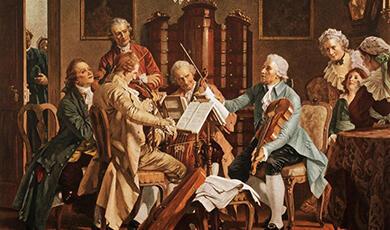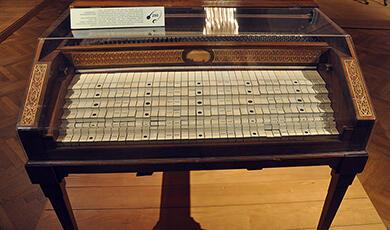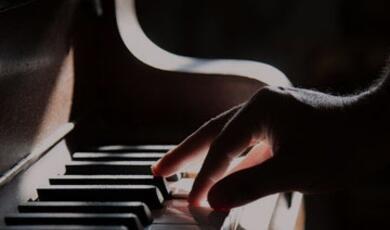Debussy - Text and Ideas: Fête galante and the Salon of Marguerite de Saint-Marceaux
Share
- Details
- Text
- Audio
- Downloads
- Extra Reading
The second half of the nineteenth century witnessed a resurgence of French interest in the Rococo period, especially in its decorative art and ornamental furnishings. Eighteenth-century fêtes galantes paintings held a special fascination; these artworks depicted such refined pursuits of elegant high society as gallant conversation and masquerade in intimate parkland settings. Claude Debussy's L'Isle joyeuse for piano (1903–4) is representative of this vogue, being inspired by Antoine Watteau's archetypal fête galante painting of 1718–19, L'Embarquement pour Cythère. Its avant-première was given in the salon of Marguerite de Saint-Marceaux on Friday 13 January 1905. Emma Adlard argues that these are all expressions of a 'private', eternal present, thereby challenging a conventional understanding of modernism as largely 'public' and progressive.
Download Text
13 April 2012
'Time-full' Interiors:
Debussy, Fête galante, and the
Salon of Marguerite de Saint-Marceaux
Emma Adlard
In the evening, dinner at Madame de Saint-Marceaux's. Afterwards, everyone asked me to play Rimsky's Concerto for Piano, accompanied by Messager. Everyone in awe, they then asked me to play, back in the salon downstairs, the new works by Debussy: Masques and L'Isle joyeuse. They were excited by my performance ... Poujaud, Blanche, the Samazeuilhs, etc., about twenty people were there.[1]
This brief entry recorded in the diary of the Spanish pianist Ricardo Viñes offers a tantalizing glimpse of the 'avant-première'of Claude Debussy's L'Isle joyeuse for piano: an event that took place on Friday 13 January 1905 at the Parisian salon of Marguerite de Saint-Marceaux.[2] Although no doubt influenced by Paul Verlaine's Fêtes galantes poems of 1869, Debussy's L'Isle joyeuse is believed to have been inspired principally by Antoine Watteau's fête galante painting of 1718-19: L'Embarquement pour Cythère (see Appendix, Figure 1).[3]Debussy was not alone in his infatuation with Watteau: on returning to Paris in 1887 following a two-year stint in Rome, the composer found the French capital captivated by a Rococo revival led by the naturalist writers and aristocrats, Jules and Edmond Goncourt.[4] Eighteenth-century fête galantespaintings held a special fascination, especially those by Watteau who 'invented' the genre. These artworks, inspired by the enchanted worlds of Venice and Versailles, depicted such refined pursuits of elegant high society as gallant conversation, music-making, and masquerade in intimate parkland settings. Demand by French salonnières and socialites at the turn of the century for musical works that thematised these courtly recreations, such as Debussy's L'Isle joyeuse,was at its peak.[5]
While records of the avant-première of L'Isle joyeuse are scarce, more general testimonies relating to the Saint-Marceaux salon or to Debussy's piano piece are numerous. Taken together, these accounts raise intriguing questions of class, gender, performance space, and artistic inspiration. For the purposes of this paper, I intend to focus on just the last two: namely, the suitability of an intimate salon milieu for the first performance of L'Isle joyeuse, and the implications of Debussy's compositional influences. In order to provide answers to these questions however, I need first to inquire into the changing understandings of time and space at the fin de siècle; second, to delineate this period's restoration of the Rococo style; and third, to look closely at Watteau's fêtes galantes tableaux. Only then will we be ready to return to the Saint-Marceaux salon and to Debussy's island of pleasure.
While the introduction of World Standard Time in France in 1891[6] achieved its principal aim – greater uniformity of public time – it also had a more unexpected consequence: by drawing attention to the pluralities of time, even as it sought to eradicate them, Standard Time spawned a vast body of theory affirming private, heterogeneous temporalities.[7]In particular, the idea of a simultaneous present, thickened with retentions and protentions of the past and future, was a theory that was to prove highly influential for writers, scientists, and artists alike.[8]At the end of the nineteenth century, the French philosopher Henri Bergson revolutionised the traditional understanding of temporality as a unidirectional series of fixed points. According to his theory of la durée, which he first defined in 1889 as 'a succession of qualitative changes, which melt into and permeate one another',[9] time is always in the act of becoming; it is an indivisible flux in which experiences of past, present and future interpenetrate.[10]
Bergson's influential philosophy was to make a strong impression on Marcel Proust in the early years of the twentieth century. Along with writers such as James Joyce and Virginia Woolf, Proust transformed the novel's sense of time and space into a modernist heterogeneity of temporalities and locales that shifted with the changing perceptions of human subjectivities.[11]A characteristic example of this is the episode in La Prisonnière, the fifth volume of A la recherche du temps perdu, in which the musical continuity of the narrator's solitary performance of Vinteuil and Wagner opposes his more flexible experience of time as his mind drifts and he only half-attentively listens to his own musical production.[12]For musicologist Cormac Newark, this scene's unresolved tension between exterior performance 'in time' and interior reflection 'out of time' – which he describes as a Proustian 'subjective double-think'[13]–gives A la recherche musical structure[14]: 'not that it is organised on a large scale according to specifically musical principles of form, as many have claimed, but that in its descriptions of the process of opera it keeps in such obvious and constant tension the listener's engagement with musical movement through time, and his mysterious, magical detachment from it.'[15]According to Newark, a musical moment such as this conjures an imaginatively amorphous space for critical reflection on questions of art and existence as opposed to haphazard emotional perception.[16]
The fact that Proust employed a musical episode to explore temporal complexity is no coincidence. La durée was believed to be almost impossible to express verbally and by the early twentieth century, music's status as the simultaneous art par excellence was widely accepted; its contrapuntal possibilities provided the archetype for painting and poetry alike.[17]Above all, it would seem that the elusive music of Claude Debussy was believed to capture most accurately the indeterminable condition of human experience in time. The French musicologist Louis Laloy spoke of 'secret correspondences'[18] linking Debussy's compositions with Bergson's theories and Bergson himself described Debussy's music as 'une musique de la « durée »'.[19]
Whilst French philosophers, writers and artists at the turn of the centurydemonstrated a peculiar interest in the experience of a simultaneous present time, the past commanded a related fascination of its own. For Bergson and Proust, for example, the past constituted a vital source of freedom and joy and derived its meaning from its positive impact upon the present.[20]The resurgent appeal of the eighteenth-century Rococo aesthetic at the fin de siècle thus appears more than coincidental. For a generation whose confident sense of the future was marred by an ambivalence towards the inexorable 'progress' of the present, the Rococo's repudiations of the sublime, of ambition and of power[21]may well have seemed apt.
In addition, the notion of the interior was as much a preoccupation of the twentieth century as it was of the eighteenth. With the x-ray now able to reveal the internal anatomy of the human body, Freud's exposé of unconscious psychological processes,[22] and the Cubists' artistic representation of objects' interiors, it is commonly thought that the internal realm during the early 1900s seemed more fundamental and accessible than ever before. During the reign of Louis XV (that is, 1715 to 1774), the French understood what would retrospectively be identified as the Rococo style specifically in terms of interiority and retreat.[23]According to Deborah Silverman, the turn-of-the-centuryappeal of the Rococo lay above all in its ability to triumph over industrialisation and metropolitan invasiveness via a retreat to a blissful interior.[24]
The image of a withdrawal to a secluded haven is captured potently in the fêtes galantes tableaux of Rococo artist Antoine Watteau, not least in his L'Embarquement pour Cythère, which enjoyed renewed fame at the fin de siècle. Yet it is not only this painting's representation of private space that aligns it with the concerns of the early 1900s, but also its representation of time. While scholars have attached great importance to the question of whether L'Embarquement depicts an arrival at or departure from the idyllic island of Cythera,[25] it may in fact be more productive to imagine this painting from a modernist perspective as a daring eschewal of rational time. In other words, I would agree with musicologist Michael Klein that there is no need to decide categorically between the two alternatives: the ambiguity is entirely the point.[26]For me, Watteau succeeds in representing temporal opposites simultaneously: the effect of stasis associated with the ecstasy of arrival as well as the demand of time signified by the pilgrims' departure.
This is an impression that is captured in microcosm by the curvature of the three couples poised on the hillock, which suggests both progressive motion in time, as Julie-Ann Plax has noted,[27]and 'a curious equipoise'[28]in the words of Michael Klein. In an analysis of 1911, Auguste Rodin described these figures as participating in 'une longue action':[29]the pair on the left have risen but turn back towards the central man and woman who are getting to their feet; this couple is in turn connected to the pilgrims on the far right who are not as yet disturbed by the passage of time. In this way, Watteau portrays concurrently the beginning of a journey, its undertaking, and its completion. The central female figure in particular, who remains firmly seated like the right-hand couple, yet is being pulled hurriedly to her feet by her lover, seems simultaneously to pine for her past, cling on to the present moment, and make haste towards her future.[30]
One might view the early twentieth-century salon in similar terms. As a progressive yet reclusive milieu that promoted both intimate sociability and private reflection, the salon represented a space that thrived on the irreconcilability of its conflicting attributes. The salon of Marguerite de Saint-Marceaux, which provided Proust with his model for the Verdurin salon in A la recherche, was characteristic of this definition;[31]its deliberately designed intimacy, for example, was noted by her guests. As the French composer Charlotte Sohy-Labey explained, 'the seats were grouped with an accomplished art in order to create corners of intimacy where one was extremely well placed for conversation'.[32]
A number of portraits sketched by Marguerite's visitors within her salon suggest that this milieu was also one conducive to private contemplation. What is so intriguing about these drawings is how many depict a solitary figure in solemn meditation, often with their eyes closed or with their head resting pensively on a hand. Contrary to what might be deemed a typically modernist blank stare, epitomised by the subject of Manet's Un Bar aux Folies-Bergère (see Appendix, Figure 2),[33] the salon habitués represented by these drawings keep their eyes firmly closed; like Proust's narrator in La Prisonnière,they turn self-consciously inwards. Several drawings of Marguerite even portray the salonnière in bed, asleep – the very image of reverie. Emilio della Sudda's portrait of Ricardo Viñes at the piano depicts the musician with his eyes firmly shut, lost in thought, as if the music has transported him somewhere beyond the here and now. Could Viñes possibly be playing Debussy's L'Isle joyeuse?
Akin to Watteau's L'Embarquement pour Cythère, which offers a fantastical image of an eighteenth-century haven, L'Isle joyeuse is a work that affords its listener the opportunity to retreat into an interior dream world. In particular, the work's initial cadenza functions ritualistically, according to James Hepokoski, as a threshold 'linking secular and sacred/aesthetic space – linking the "normal" (but sadly banal and unclean) world with the purer world of enchantment and art.'[34]Moreover, Watteau's representation of both stasis and the relentless march of time within a single painting is a technique replicated by Debussy in L'Isle joyeuse. Within the framework of the work's 'open, irreversible wedge progression',[35]in the words of Roy Howat, localised instances of stasis and circularity subsist, especially in the form of non-developmental melodic patterns, non-goal-oriented harmonies, and pedal points.
Whenever the music becomes overly insistent, driving ever towards its conclusion, Debussy almost always holds it in check. Arguably the most conspicuous example of this is the passage beginning at bar 67. Marked '[u]n peu cédé. Molto rubato', time here is literally 'cédé' or 'surrendered' – an impression aided by the undulating quintuplet semiquavers in the left hand that obscure the straight quaver rhythms of the right hand (see Appendix, Figure 3). At this moment, the pianist is instructed to defy the progressive musical narrative of L'Isle joyeuse and to give in to his/her own flexible sense of time. In its vacillation between static and more vigorous passages then, L'Isle joyeuse might be seen to embody Cormac Newark's notion of the Proustian 'subjective double-think': when an exterior engagement with music's advancement 'in time' exists in an ambiguous relationship with an interior, 'out of time' experience.
Although not a reconciliation as such, the climax beginning at bar 220 achieves its potency from the ambiguous simultaneity, I suggest, of the static and the dynamic. At this moment, the boundaries demarcating 'interior' and 'exterior' become blurred and the two states finally coincide: although marked fortissimo and featuring urgent rhythmic articulation, the performer is nonetheless instructed to play this passage '[u]n peu cédé' and to bring the inner melodic voice suspended over the bar lines to the foreground (see Appendix, Figure 4). Debussy thus chooses to inscribe this euphoric climax with the ecstasy of inertia.
Although Debussy's music has often been described as 'timeless', something closer to 'time-full' would thus seem more appropriate a characterisation. Just like the central female figure in Watteau's painting, Debussy's composition holds fast to the present moment and yet hastens to its destiny. In the same way that it is irrelevant whether the pilgrims in L'Embarquement are arriving or departing from the island of Cythera, it is equally futile to prioritise the static over the dynamic in L'Isle joyeuse or vice versa: ultimately, Debussy's music, like Watteau's art, inhabits an ambiguous temporal mode of simultaneity.
Although to my knowledge no record exists of Marguerite's own response to the avant-première of L'Isle joyeuse in her salon, it is evident that she held Debussy in high esteem, praising his works repeatedly in her diary as 'chefs-d'oeuvre'. Above all, Marguerite seemed to locate the brilliance of Debussy's music in its intimacy and invitation to private reverie. In her journal, she describes Pour le piano as 'unique and private music'[36]and the first two movements of Nocturnes as 'exquisite works of art. Music of dream and feeling. I close my eyes and I am completely satisfied. This music realises all my desires for art, it sums up my most acute feelings.'[37]Perhaps, however, Marguerite's most revealing diary entry regarding her affinity with the music of Debussy is that anticipating a performance of Pelléas et Mélisande at the Opéra-Comique in 1902: 'I am going to hear Pelléas and Mélisande, hidden at the back of an opera box, and to enjoy [jouir] the purest art ever written in music.'[38]Marguerite's excitement at the prospect of experiencing Pelléas in the privacy of an opera box suggests that an intimate space is best suited to experience the jouissance of Debussy's art.
And so it was also for the French pianist Marguerite Long. In a revealing passage of her memoirs, Long recalls one Sunday spent with Debussy working on L'Isle joyeuse. In particular, she explains how the composer conceived of the introductory cadenza '"as a summons"'[39]– perhaps, we might speculate, to private reverie – and she draws a stark distinction between the soothing dream conjured by the drawing-room performance and the outside world at war:
Those moments that were left to us were a sort of truce. The luxurious, tranquil drawing-room welcomed us. Through an open window the strains of L'Isle joyeuse flowed from that lyrical house towards the brutality inherent in the streams of departing soldiers.[40]
The overwhelming impression that emerges from these testimonies of the two Marguerites is that the music of Debussy – even his more virtuosic or large-scale works – seemed particularly suited to performance, or at least reception, within a secluded environment. The intimate Saint-Marceaux salon might thus be considered an especially suitable performance setting for L'Isle joyeuse – all the more so given the work's eighteenth-century inspiration, for, as K. R. Ireland has argued, the Rococo aesthetic finds its most characteristic expression in interior milieux.[41]
While the influence of the fêtes galantes on Debussy's music has previously been explored, here I have expanded the interpretative sphere in order to incorporate the salon environment; to engage with this locale would seem to be an illuminating move when it comes to dealing with questions of time and space. In their invitation to subjective reverie, Debussy's L'Isle joyeuse and the Saint-Marceaux salon seem to have functioned symbiotically to ensure the recuperation of private temporalities and locales (both real and imagined) that were threatened by more 'public' notions of time and space at the fin de siècle. Moreover, in the twentieth-century French imagination, looking back, for example to the eighteenth century, necessarily also implied looking ahead and vice versa.[42] It is indeed this same ambiguous sense of temporal simultaneity that connects Watteau's L'Embarquement pour Cythère, Debussy's L'Isle joyeuse, and the salon of Marguerite de Saint-Marceaux. Their 'time-fullness' and interiority, I propose, are vital sources of their efficacy.
Ultimately, a simplistic conflation of French modernism, speed, and progress, as has tended to be the norm in popular history, remains open to discussion. For a generation that aspired to triumph over time and space,[43]images of stasis, nostalgia and retrospectivism were equally prevalent and expedient, and therefore just as characteristic of the French modernist movement. While an interpretative dance, such as the present discussion, between painting, music, and space will thus always involve leaps of faith, bringing these media into close contact in this context has revealed intriguing connections between the three and serves to challenge our existing, albeit deficient understanding of the meaning of French modernism.
© Emma Adlard 2012
[1]'Le soir, dîner chez Mme de Saint-Marceaux. Après, tout le monde m'a demandé de jouer le Concerto pour piano de Rimski que m'a accompagné Messager. Tous en admiration, ils m'ont ensuite demandé, de retour au salon d'en bas, les nouveaux morceaux de Debussy : Masques et L'Isle joyeuse. Ils furent enthousiasmés par mon exécution … Il y avait Poujaud, Blanche, les Samazeuilh, etc., une vingtaine de personnes.' (Ricardo Viñes quoted in Marguerite de Saint-Marceaux, Journal, 1894-1927 / Marguerite de Saint-Marceaux, ed. Myriam Chimènes (Paris: Fayard, 2007), p. 374, n. 1). All translations in this paper are my own unless otherwise stated.
[2]Both Christian Goubault and Myriam Chimènes confirm Viñes' presentation of Debussy's Masques and L'Isle joyeuse in the salon of Marguerite de Saint-Marceaux on 13 January 1905 as these works' first performances. (Christian Goubault, Claude Debussy (Paris: Champion, 1986), p. 181; Myriam Chimènes, Mécènes et musiciens : du salon au concert à Paris sous la IIIe république (Paris: Fayard, 2004), p. 80).
[3]L'Embarquement pour Cythère, on display in the Charlottenburg Palace in Berlin, is the second version of Watteau's original Le Pèlerinage àl'île de Cythèreof 1717, belonging to the Louvre. Although there exists some discrepancy among scholars as to which of the two paintings was Debussy's inspiration, the composer is known to have specifically cited L'Embarquement pour Cythère when working with pianists on L'Isle joyeuse. (Claude Debussy, Correspondance: 1872-1918, ed. François Lesure, Denis Herlin and Georges Liébert (Paris: Gallimard, 2005), p. 1835, n. 4).
[4] Anya Suschitzky, 'Debussy's Rameau: French Music and Its Others', The Musical Quarterly, Vol. 86, No. 3 (Autumn, 2002), 398-448 (406); Deborah Silverman, Art Nouveau in Fin-de-siècle France: Politics, Psychology, and Style (Berkeley: University of California Press, 1989), p. 17.
[5]Michel Faure, 'L'Époque 1900 et la résurgence du mythe de Cythère', Le Mouvement social, No. 109 (October – December 1979), 15-34 (20).
[6]Anne Green, Changing France: Literature and Material Culture in the Second Empire (London: Anthem, 2011), p. 55, n. 77.
[7]Stephen Kern, The Culture of Time and Space: 1880-1918 (Cambridge, MA: Harvard University Press, 2003), p. 33.
[8]Ibid., p. 314.
[9]Henri Bergson, Time and Free Will: An Essay on the Immediate Data of Consciousness, trans. F. L. Pogson (Mineola, NY: Dover, 2001), p. 104.
[10]Gilles Deleuze, Bergsonism, trans. Hugh Tomlinson and Barbara Habberjam (New York: Zone Books, 1988), p. 13.
[11]Kern, The Culture of Time and Space, p. 149.
[12]Cormac Newark, Opera in the Novel from Balzac to Proust (Cambridge: Cambridge University Press, 2011), pp. 167, 191-2.
[13]Ibid., p. 196.
[14]Ibid., pp. 191-2, 194, 197.
[15]Ibid., pp. 196-7.
[16]Ibid., pp. 167, 187.
[17]Kern, The Culture of Time and Space, pp. 25, 75.
[18]Louis Laloy, 'La Musique chez soi : M. Henri Bergson et la Musique,' Comœdia (February – March 1914) quoted in Jann Pasler, 'Debussy, Jeux: Playing with Time and Form', 19th-Century Music, Vol. 6, No. 1 (Summer, 1983), 60-75 (74).
[19]Henri Bergson, Mélanges : L'idée de lieu chez Aristote, Durée et simultanéité, correspondance, pièces diverses, documents (Paris: Presses universitaires de France, 1972), p. 844.
[20]Kern, The Culture of Time and Space, pp. 45-6.
[21]Rémy G. Saisselin, 'The Rococo as a Dream of Happiness', The Journal of Aesthetics and Art Criticism, Vol. 19, No. 2 (Winter 1960), 145-52 (146).
[22]Freud's theories relating to the interior psyche are in fact often bound up with the notion of timelessness. In 'Beyond the Pleasure Principle' for example, Freud concludes that 'unconscious mental processes are in themselves "timeless." That is to say, first of all, that they are not ordered chronologically, that time changes nothing in them, and that one cannot apply to them the concept of time.' (Sigmund Freud, Beyond the Pleasure Principle, ed. Todd Dufresne, trans. Gregory C. Richter (Peterborough, ON; Buffalo, NY: Broadview, 2011), p. 69).
[23]Silverman, Art Nouveau in Fin-de-siècle France, p. 9.
[24]Ibid., p. 17.
[25]That this question – the subject of a 1961 essay by Michael Levey – was still being discussed over forty years later by Julie-Ann Plax is evidence of the durability of the debate. (See Michael Levey, 'The Real Theme of Watteau's Embarkation for Cythera', The Burlington Magazine, Vol. 103, No. 698 (May, 1961), 180-5; Julie-Ann Plax, Watteau and the Cultural Politics of Eighteenth-Century France (Cambridge: Cambridge University Press, 2000), p. 143).
[26]Michael Klein, 'Debussy's L'Isle joyeuse as Territorial Assemblage', 19th-Century Music, Vol. 31, No. 1 (Summer, 2007), 28-52 (30).
[27]Plax, Watteau and the Cultural Politics of Eighteenth-Century France, p. 146.
[28]Klein, 'Debussy's L'Isle joyeuse as Territorial Assemblage', 30.
[29]Auguste Rodin, L'Art (Paris: B. Grasset, 1912), p. 97.
[30]Klein, 'Debussy's L'Isle joyeuse as Territorial Assemblage', 30.
[31]'Une famille d'artiste en 1900 : Les Saint-Marceaux', Musée d'Orsay,<http://www.musee-orsay.fr/en/events/exhibitions/in-the-musee-dorsay/exhibitions-in-the-musee-dorsay/article/une-famille-dartiste-en-1900-les-saint-marceaux-4111.html?cHash=bff9e79d2f>, last accessed 14 October 2011; Chimènes, Mécènes et musiciens, p. 68.
[32]'[L]es sièges étaient groupés avec un art consommé pour former des coins d'intimité où l'on était fort bien pour causer'. (Charlotte Sohy-Labey, Le Salon de Mme de S. quoted in Michel Nectoux, 'Musique et beaux-arts : le salon de Marguerite de Saint-Marceaux' in Les Saint-Marceaux : une famille d'artistes en 1900, Les Dossiers du Musée d'Orsay, No. 49 (Paris: Réunion des Musées nationaux, 1992), 62-90 (74)).
[33]For a detailed discussion of this painting, see T. J. Clark, 'A Bar at the Folies-Bergère' in The Painting of Modern Life: Paris in the Art of Manet and His Followers, rev. ed. (Princeton, N. J.: Princeton University Press, 1999), 205-58.
[34]James A. Hepokoski, 'Formulaic Openings in Debussy', 19th-Century Music, Vol. 8, No. 1 (Summer, 1984), 44-59 (54).
[35]Roy Howat, 'Debussy, Masques, L'Isle joyeuse, and a Lost Sarabande', Musicology Australia, Vol. 10 (1987), 16-30 (21).
[36]'3 nouvelles [pièces] pour le piano de Debussy, Toccata, Sarabande [, Prélude ?] De la musique unique et personelle.' (Saint-Marceaux, Journal, p. 264).
[37]'[O]euvres d'art exquises. Musique de rêve et d'impression. Je ferme les yeux et je suis absolument satisfaite. Cette musique réalise tous mes désirs d'art, elle résume mes sensations les plus aiguës.' (Ibid., p. 230).
[38]'[J]e vais entendre Pelléas et Mélisande cachée dans le fond d'une loge, et jouir de l'art le plus pur qui ait jamais été écrit en musique.' (Ibid., p. 271).
[39]Marguerite Long, At the Piano with Debussy, trans. Olive Senior Ellis (London: Dent, 1972), p. 37.
[40]Ibid., p. 9.
[41]K. R. Ireland, 'Aspects of Cythera: Neo-Rococo at the Turn of the Century', The Modern Language Review, Vol. 70, No. 4 (October 1975), 721-30 (726).
[42]Silverman, Art Nouveau in Fin-de-siècle France, p. 12.
[43]Paul Adam, La Morale des sports (Paris: Librairie Mondiale, 1907), p. 450 quoted in Kern, The Culture of Time and Space, p. 111.
Part of:
This event was on Fri, 13 Apr 2012
Support Gresham
Gresham College has offered an outstanding education to the public free of charge for over 400 years. Today, Gresham College plays an important role in fostering a love of learning and a greater understanding of ourselves and the world around us. Your donation will help to widen our reach and to broaden our audience, allowing more people to benefit from a high-quality education from some of the brightest minds.


 Login
Login







